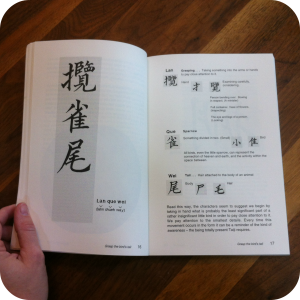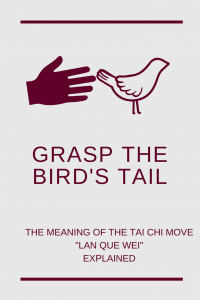The meaning of Grasp the Bird’s Tail (揽雀尾 Lǎn Qùe Wěi)
One of the most important movements in Taijiquan is to Grasp the Bird’s Tail. Actually it is a series of very basic moves: Peng, Lü, Ji and An.
It is not only called Grasp the Bird’s Tail, some call it “Grasp the Sparrow’s Tail” and the Chinese name is Lǎn Qùe Wěi (揽雀尾 or simplified 拦雀尾).
Grasp the Bird’s Tail is a movement you will learn quite early in many forms, e.g. the 24 form or Yang long form (108). These moves are just so important that there are shorter Taijiquan forms which basically consist of only Grasping the Bird’s Tail!
That is why I wanted to find out what that name means. I do not speak Chinese, but on my quest for an answer I found this really interesting book: How to Grasp the Bird’s Tail if You Don’t Speak Chinese*

The author Jane Schorre practices Taijiquan for more than 30 years. She is also not a Chinese native speaker, but she started to get interested in the names of the Taijiquan movements.
Talking to a Chinese friend, she found out about all the different aspects that are within the Chinese names and characters. To improve her understanding of Taijiquan, she wanted to get even deeper into it.
So she started researching all kinds of meanings and stories. However, she wanted to stay playfully and not become too academic in her explanations. I think that makes the book really a pleasurable read.
In the book you will find a calligraphy on the left and an explanation of all the Chinese characters on the right. Sometimes Jane Schorre added some complementary notes and thoughts. This for example is the page of “Grasp the Bird’s Tail”:

So now let’s get deeper into these Chinese characters:
- Lǎn 揽 (or simplified 拦) means grasping. It actually consists of two characters: one for “hand” and one for “examining carefully”
- Qùe 雀 is a sparrow. It also consists of two characters: “small” and “bird”
- Wěi 尾 means tail. The character can be divided in “body” and “hair”
So the short direct translation of Lan Que Wei (揽雀尾) could be “Grasp Bird Tail”. But you could also say “Hand examine carefully small bird’s body hair”!
As I said, Jane Schorre adds comments to most of the moves and Chinese characters. And I think that is really valuable. They are often ideas for practicing Taijiquan. So she writes about Grasp the Bird’s Tail:
“Read this way, the characters seem to suggest we begin by taking in hand what is probably the least significant part of a rather insignificant little bird in order to pay close attention to it. We pay attention to the smallest details. Every time this movement occurs in the form it can be a reminder of the kind of awareness – the being totally present Taiji requires.” (page 17*)
Wow! I have to admit that I am some kind of detail freak in the Taijiquan form. So I find it magnificent that there is what I would call a “mind the details-reminder” implemented in the form!
And of course I think this would be a good time for you to get up and practice this: mind the details in Peng, Lü, Ji, An: Grasp the Bird’s Tail!
Happy Qi!
Angelika
P.S.: Unfortunately How to Grasp the Bird’s Tail if You Don’t Speak Chinese* is out of print. If you ever find it somewhere I highly recommend you buy it! The book is truly inspiring no matter which Taijiquan style you practice.

Comments are closed.

21 Comments
I think that people training in Tai Chi are very prone to “navel gazing” – diving deeply into more and more esoteric meanings that, really, have very little bearing on the kinds of things we deal with in everyday life.
It must be remembered that Tai Chi WAS and IS a martial art. ALL the postures and transitions started first as martial techniques – techniques for neutralising and diverting attacks for the purpose of creating an advantageous position for counterattacks – which would, through a flowing martial artist’s attack, consist of destabilising, striking, and then throwing or locking an opponent – with the intention of completely removing their capacity to be a threat.
Grasping the Bird’s Tail is a core fighting technique of Tai Chi Chuan. It is a mechanism to meet and divert an opponent’s attack, disrupt their centre of balance, and to provide the Tai Chi fighter with devastating advantage in the counter attack. It usfues a “splitting” method, common to the so-called internal arts (but also to “external” arts.
There is no magic and there are no real secrets in Tai Chi. There is knowledge that we can learn academically – but that we can only really know through full contact practice – on the mats and, indeed, in full contact experience. Not everyone can do or have this – but no one who has not trained in this way, or at the very least, who has trained with people who have walked this path, can call themselves a senior Tai Chi instructor – not with any credibility, anyway.
Hi Cormac,
thanks for your comment!
Sure, Taijiquan is a martial art and that is what I like about it: it is about communication. You ask for full contact experience, I have to admit that I am content with less. Though I like practicing alone, additionally I am very interested in what happens when there is an opponent!
I also prefer to learn the form including the applications because it makes it easier for me to understand the movement. And because the Chinese culture and language is foreign to me, I like to digg deeper into the movement names!
Angelika
The traditional character for grasping is 攬 – as per the book in your photo. Perhaps it’s a matter of typeface but the version you posted is also a simplified form.
Thank you for your comment! I changed the character – I am simply not that good at Chinese characters. I hope one day I will learn Chinese!
Thanks for the information!
Every bit helps…
your’re welcome! Yes, practicing Taijiquan is really a big collection of bits and pieces and somehow it all comes together
Hi Angelika.
Although I appreciate this author’s efforts to analyze the deeper meanings of Taijiquan postures, this particular explanation seems to be her own unique invention. The orthodox meanings cannot be derived through textual analysis.
From the Yang family to my ears — “Grasp the Bird’s Tail” refers to sensitivity in the hands and body, such that a small bird could not effectively push itself away in preparation for flying. It refers to yielding. It is therefore the opposite of grasping a bird to hold it in place.
Some people speculate that this entire sequence was derived from Chen style “Lazily Tying Coat.” This refers to a special coat the Chens used to repel angry birds.
That last part was a joke… but I wouldn’t be surprised to find it in an English Tai Chi manual ten years from now! Ha ha.
Hi Chris,
yes, I am sure the book does not show all possible meanings! There are surely many more interpretations, stories, myths etc. around all the movemements.
Actually I’ve heard about the story with the bird not able to fly away, but I don’T remember I heard it mentioned in the context of Grasp the Bird’s Tail. But it does make sense, too.
Angelika
Hi Angelika,
揽雀攬, the third word 攬 is written wrong. It’s the bird’s tail and should be 尾.
You have used the same word as the first word 揽. The first word and the third word you used are the same. The difference of the 2 words is, first one is simplified Chinese.
Thanks
Thank you, I changed that! Really confusing those Chinese characters!
Angelika
I have an excellent copy of the book for sale if anyone is interested.
Anyone interested can write me an eMail, I will connect you!
Angelika
Thanks Angelika
I had just mentioned this book to a friend who is a tai chi practitioner and learning Chinese calligraphy. When you find the book available at all the price is extremely high. I suggested she check out the library system as it is available at several.
Your review was nicely done and conveyed a good idea of the book’s topic.
Thank you,
yes, I know the book is out of print. I hope one day there will be a new edition!
Angelika
Gee some of your readers are really picky.
Remember old laosau said
He who knows does not say
He who says does not know
Ed
I have it in English as Lan Ch’iao Wei and then tso p’eng and yu p’eng (left ad right). Perhaps the difference is Mandarin to Cantonese?
if this book is available, I am interested, depending on price and condition.